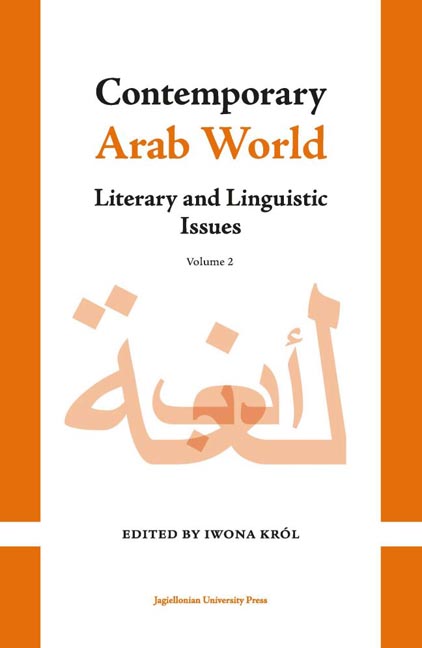Book contents
- Frontmatter
- Contents
- Introduction
- Karīm Maʿtūq and Other Winners of Amīr ash-shuʿarāʾ (Prince of Poets) First Contest
- Muḥammad Ibn Dāniyāl al-Mawṣilī – Arabic Aristophanes of Shadow Theatre
- Connotations of Home in Contemporary Palestinian Poetry – ʿAbd Allāh ʿĪsā’s Texts as an Example
- The “Mad Arab” Abdul Alhazred – Orient and Orientalism in the Works of Howard Phillips Lovecraft
- Functions of the Suffix -at in Nouns in Modern Standard Arabic
- Some Remarks on the Nature of Moroccan Regionalisms Based on the Analysis of University Admission Announcements
- Polish Deverbal Verbs and Their Hebrew Equivalents – A Contrastive Analysis Outline
- Annex: Abstracts – Streszczenia
- Miscellaneous Endmatter
Polish Deverbal Verbs and Their Hebrew Equivalents – A Contrastive Analysis Outline
Published online by Cambridge University Press: 13 October 2023
- Frontmatter
- Contents
- Introduction
- Karīm Maʿtūq and Other Winners of Amīr ash-shuʿarāʾ (Prince of Poets) First Contest
- Muḥammad Ibn Dāniyāl al-Mawṣilī – Arabic Aristophanes of Shadow Theatre
- Connotations of Home in Contemporary Palestinian Poetry – ʿAbd Allāh ʿĪsā’s Texts as an Example
- The “Mad Arab” Abdul Alhazred – Orient and Orientalism in the Works of Howard Phillips Lovecraft
- Functions of the Suffix -at in Nouns in Modern Standard Arabic
- Some Remarks on the Nature of Moroccan Regionalisms Based on the Analysis of University Admission Announcements
- Polish Deverbal Verbs and Their Hebrew Equivalents – A Contrastive Analysis Outline
- Annex: Abstracts – Streszczenia
- Miscellaneous Endmatter
Summary
Research aims and methods
1.a. Deverbal verbs as against deadjectival and denominal verbs in bilingual lexicography
Henryk Wróbel pointed out in his work that the derivation of Polish verbs involves mainly prefixes added to the base, and to a lesser extent suffixes that determine the inflection of the derived verb. The base for creating a verb can be another verb (for example the base: pisać ‘to write’ > deverbal verbs: odpisać ‘to write back,’ pisywać ‘to write from time to time,’ podpisać ‘to sign’), an adjective (the base: biały ‘white’ > deadjectival verbs: bieleć ‘to be seen as white,’ wybielić ‘to whiten’) or a noun (the base: dom ‘a house’ > denominal verbs: udomowić ‘to domesticate,’ zadomowić się ‘to get settled’) (Wróbel 1999: 536, the examples are mine). The derivation of Semitic verbal lexemes consists in forming stems that merge two “discontinuous morphemes”: the consonantal root of the base and the transfix assigned to a given stem, called “pattern” (Joüon 1996: 109–110; Boudelaa, Marslen-Wilson 2005: 207, 209; Broselow 2008: 552, 554). As in Polish, the base of a derived Hebrew verb can be another verb (the base: katav ‘to write’ > deverbal verbs: hiħtiv ‘to dictate,’ hitkatev ‘to correspond’), an adjective (the base: adom ‘red’ > deadjectival verb: heʾedim ‘to become red / redden’) or a noun (the base: bayit ‘a house’ > denominal verbs: biyet ‘to domesticate,’ hitbayet ‘to get settled’).
When translating between Hebrew and Polish, in most cases one easily finds equivalents for deadjectival and denominal verbs: heʾedim = zaczerwienić się, biyet = udomowić, because in both languages their meaning is often expressed by a single, distinct verbal lexeme, as in the provided examples, and at least one member of the pair of mutual translational equivalents is listed in bilingual dictionaries. What is meant here by distinct lexeme, is the fact, that due to a substantial difference in grammatical function between the base and the derived verb in the case of deadjectival or denominal verbs, which is a result of moving from one part of speech (adjective, noun) to another (verb), it seems inconceivable that both the base (adjective or noun) and the derived verb of one language would have as their translational equivalent the same lexeme of the other language.
- Type
- Chapter
- Information
- Contemporary Arab WorldLiterary and Linguistic Issues, pp. 105 - 166Publisher: Jagiellonian University PressPrint publication year: 2022



